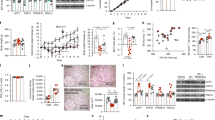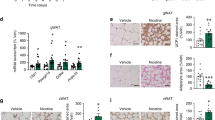Abstract
OBJECTIVE: To evaluate whether the lipolytic effects of systemic nicotine are not only attributed to indirect adrenergic mechanisms, but also to a direct action of nicotine on fat cells.
DESIGN: The effect of a systemic nicotine infusion (0.5 µg/kg/min for 30 min) on lipolysis in subcutaneous adipose tissue was investigated in situ in 11 non-obese, non-smoking, healthy male subjects under placebo-controlled conditions.
MEASUREMENTS: By using microdialysis probes the glycerol levels (lipolysis index) and blood flow were monitored locally in subcutaneous adipose tissue.
RESULTS: Plasma nicotine levels peaked (7.2 ng/ml) at the end of the infusion. Nicotine induced a mean (±s.e.) percentage peak increase in adrenaline and noradrenaline plasma levels of 213±30% (P<0.01) and 118±5% (P<0.05), respectively. Nicotine increased venous plasma glycerol levels by 144±9% (P<0.001), arterialized plasma glycerol levels by 148±12% (P<0.001) and adipose glycerol levels by 148±16% (P<0.001), but did not alter blood flow. By inducing a local cholinoceptor blockade with mecamylamine (10−5 M) via the microdialysis system, the increase in adipose glycerol levels was inhibited by ∼45% (P=0.02). A corresponding local beta-adrenoceptor blockade with propranolol (10−4 M), inhibited the increase in adipose glycerol levels by ∼60% (P=0.02). Infusion of saline (ie placebo) had no effect on the parameters mentioned above.
CONCLUSION: Systemically administered nicotine induces lipolysis, in part by activating the classical adrenergic mechanism (mediated by a nicotine-induced release of catecholamines stimulating beta-adrenoceptors), and in part by directly activating a nicotinic cholinergic lipolytic receptor located in adipose tissue.
This is a preview of subscription content, access via your institution
Access options
Subscribe to this journal
Receive 12 print issues and online access
$259.00 per year
only $21.58 per issue
Buy this article
- Purchase on Springer Link
- Instant access to full article PDF
Prices may be subject to local taxes which are calculated during checkout





Similar content being viewed by others
References
McBride PE . The health concequences of smoking Med Clin N Am 1992 76: 333–353.
Frayn KN, Williams CM, Arner P . Are increased plasma non-esterified fatty acid concentrations a risk marker for coronary heart disease and other chronic diseases? Clin Sci 1996 90: 243–253.
Eliasson B, Smith U . Leptin levels in smokers and long-term users of nicotine gum Eur J Clin Invest 1999 29: 145–152.
Oeser A et al. Plasma leptin concentrations and lipid profiles during nicotine abstinence Am J Med Sci 1999 318: 152–157.
Lafontan M, Berlan M . Fat cell adrenergic receptors and the control of white and brown fat cell function J Lipid Res 1993 34: 1057–1092.
Cryer PE et al. Norepinephrine and epinephrine release and adrenergic mediation of smoking-associated hemodynamic and metabolic events New Engl J Med 1976 295: 573–577.
Hellerstein MK et al. Effects of cigarette smoking and its cessation on lipid metabolism and energy expenditure in heavy smokers J Clin Invest 1994 93: 265–272.
Andersson K, Eneroth P, Arner P . Changes in circulating lipid and carboxyhydrate metabolites following systemic nicotine treatment in healthy men Int J Obes Relat Metab Disord 1993 17: 675–680.
Andersson K, Arner P . Cholinoceptor-mediated effects on glycerol output from human adipose tissue using in situ microdialysis Br J Pharmac 1995 115: 1155–1162.
Arner P, Bülow J . Assessment of adipose tissue metabolism in man: comparison of Fick and microdialysis techniques Clin Sci 1993 85: 247–256.
Tossman U, Ungerstedt U . Microdialysis in the study of extracellular levels of amino acids in the rat brain Acta Physiol Scand 1986 128: 9–14.
Galitsky J, Lafontan M, Arner P . Role of vascular alpha-2 adrenoceptors in regulating lipid mobilization from human adipose tissue J Clin Invest 1993 91: 1997–2003.
Felländer G, Linde B, Bolinder J . Evaluation of the microdialysis ethanol technique for monitoring of subcutaneous adipose tissue blood flow in humans Int J Obes Relat Metab Disord 1996 20: 220–226.
Curvall M et al. Stimulation and evaluation of nicotine intake during passive smoking: cotinine measurements in body fluids of nonsmokers given intravenous infusions of nicotine J Chromatogr 1982 232: 283–293.
Benowitz NL . Pharmacological aspects of cigarette smoking and nicotine addiction New Engl J Med 1988 319: 1318–1330.
Arner P, Kriegholm E, Engfeldt P . In vivo interactions between beta1- and beta2- adrenoceptors regulate catecholamine tachyphylaxia in human adipose tissue J Pharmac Exp Ther 1991 259: 317–322.
Leibel RL, Edens NK, Fried SK . Physiological basis for the control of body fat distribution in humans A Rev Nutr 1989 9: 417–443.
Maggs DG et al. Interstitial fluid concentrations of glycerol, glucose, and amino acids in human quadricep muscle and adipose tissue J Clin Invest 1995 96: 370–377.
Eliasson, B, Smith U, Lönnroth P . No acute effects of smoking and nicotine nasal spray on lipolysis measured by subcutaneous microdialysis Eur J Clin Invest 1997 27: 503–509.
Fredholm BB . Nervous control of circulation and metabolism involving adipose tissue. In: Cryer A, Vam RLR (eds). New perspectives in adipose tissue: structure, function and development Butterworths: Boston, MA 1985 45–64.
Rosell S, Belfrage E . Blood circulation in adipose tissue Physiol Rev 1979 59: 1078–1104.
Acknowledgements
Dr Fredrik Kuylenstierna, Pharmacia AB, Sweden, is greatly acknowledged for the measurements of nicotine and cotinine levels. The excellent technical assistance of Britt Marie Leijonhufvud, Catharina Hertel and Elisabette Dugner is greatly appreciated. This study was supported by grants from the Swedish Medical Research Council, the Swedish Tobacco Group and Clas Groschinsky Foundation.
Author information
Authors and Affiliations
Corresponding author
Rights and permissions
About this article
Cite this article
Andersson, K., Arner, P. Systemic nicotine stimulates human adipose tissue lipolysis through local cholinergic and catecholaminergic receptors. Int J Obes 25, 1225–1232 (2001). https://doi.org/10.1038/sj.ijo.0801654
Received:
Revised:
Accepted:
Published:
Issue Date:
DOI: https://doi.org/10.1038/sj.ijo.0801654
Keywords
This article is cited by
-
Maternal Smoking and Infant Low Birth Weight: Exploring the Biological Mechanism Through the Mother’s Pre-pregnancy Weight Status
Population Research and Policy Review (2021)
-
Changes in distributions of waist circumference, waist-to-hip ratio and waist-to-height ratio over an 18-year period among Chinese adults: a longitudinal study using quantile regression
BMC Public Health (2019)
-
Smoke exposure and cardio-metabolic profile in youth with type 1 diabetes
Diabetology & Metabolic Syndrome (2018)
-
Self-administered nicotine increases fat metabolism and suppresses weight gain in male rats
Psychopharmacology (2018)
-
Cardiovascular effects of electronic cigarettes
Nature Reviews Cardiology (2017)



